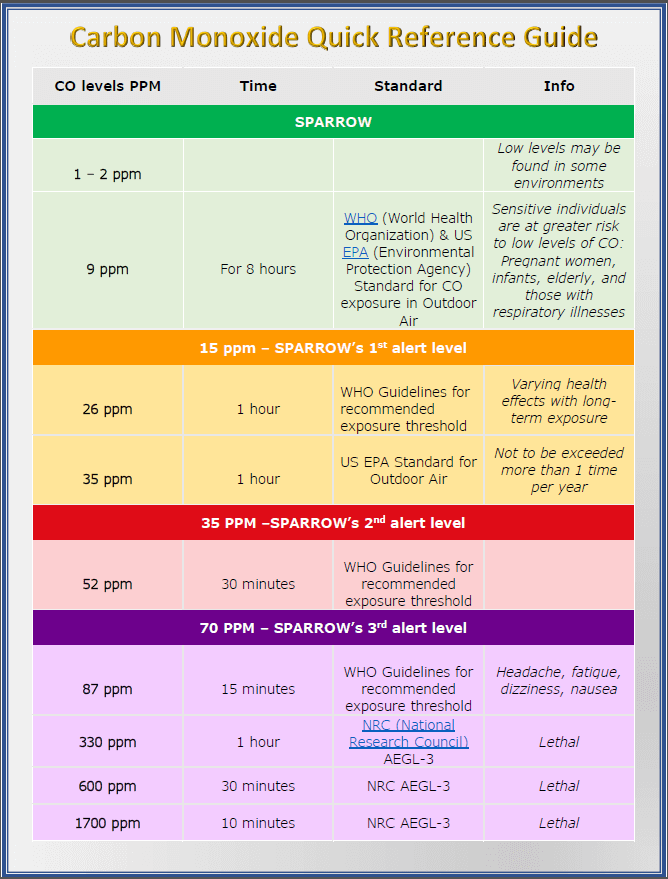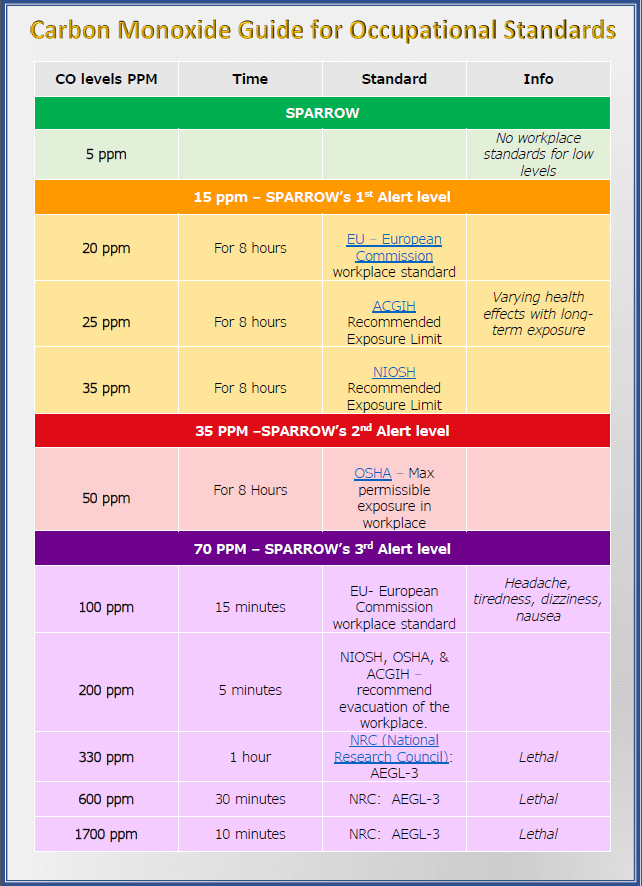Frequently Asked Questions
Home
My Data
Alerts
Learn More
Troubleshooting
Home
Reading your SPARROW
What does SPARROW measure?
Your SPARROW provides real-time measurements for temperature, humidity, and carbon monoxide measured in either ppm (parts per million) or mg/m3.
Is any level of CO normal?
Carbon monoxide exists in some environments in small amounts. You may find 1-3 ppm a typical reading for your SPARROW. If your ppm level rises, there is something in your environment that is producing carbon monoxide and you are breathing in CO.
Why do my readings fluctuate so quickly?
SPARROW’s main display updates every second, so you will continuously see updated readings for CO, Temp, & RH.
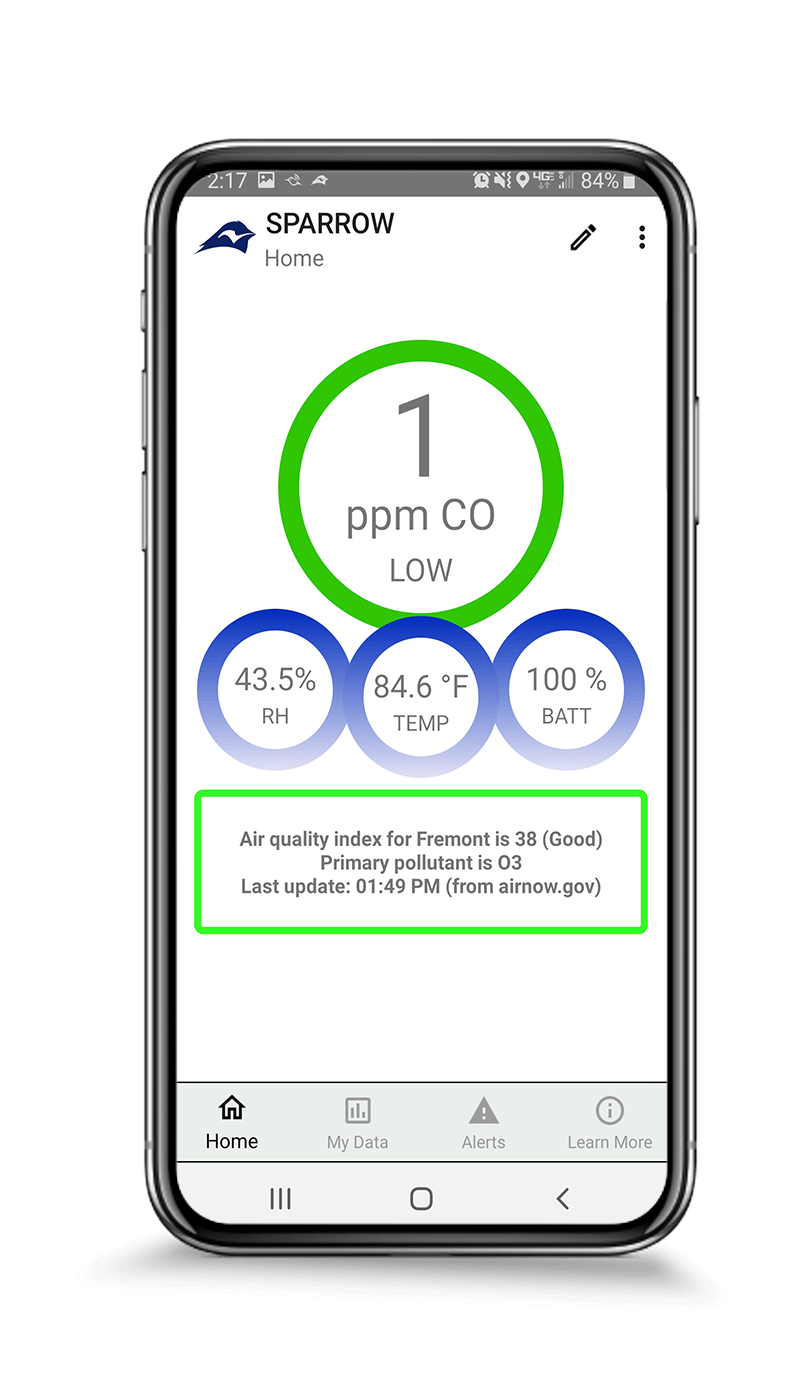
My Data
SPARROW data for air quality analysis
How do I plot data on the graph?
Click on the buttons CO, Temp, & RH to plot the data on the graph. The time toggle button below allows you to plot data for a specific time period.
What is the Event feature?
The Event feature allows you to save data for a specific moment. Events entered on the Home page, can be plotted on the My Data page.
What is the log rate for the My Data page?
The log rate for the My Data page can be customized under Settings, from 1 second to 1 day. The default log rate is 10 seconds.
How long will SPARROW data log?
In standalone mode, SPARROW will store data for up to 1 week. Upon app connection, data can be transfered from the SPARROW device to the SPARROW app, and shared via email.
What if I want to store more than 1 week of data?
The SPARROW app can store several months of data for analysis over time.
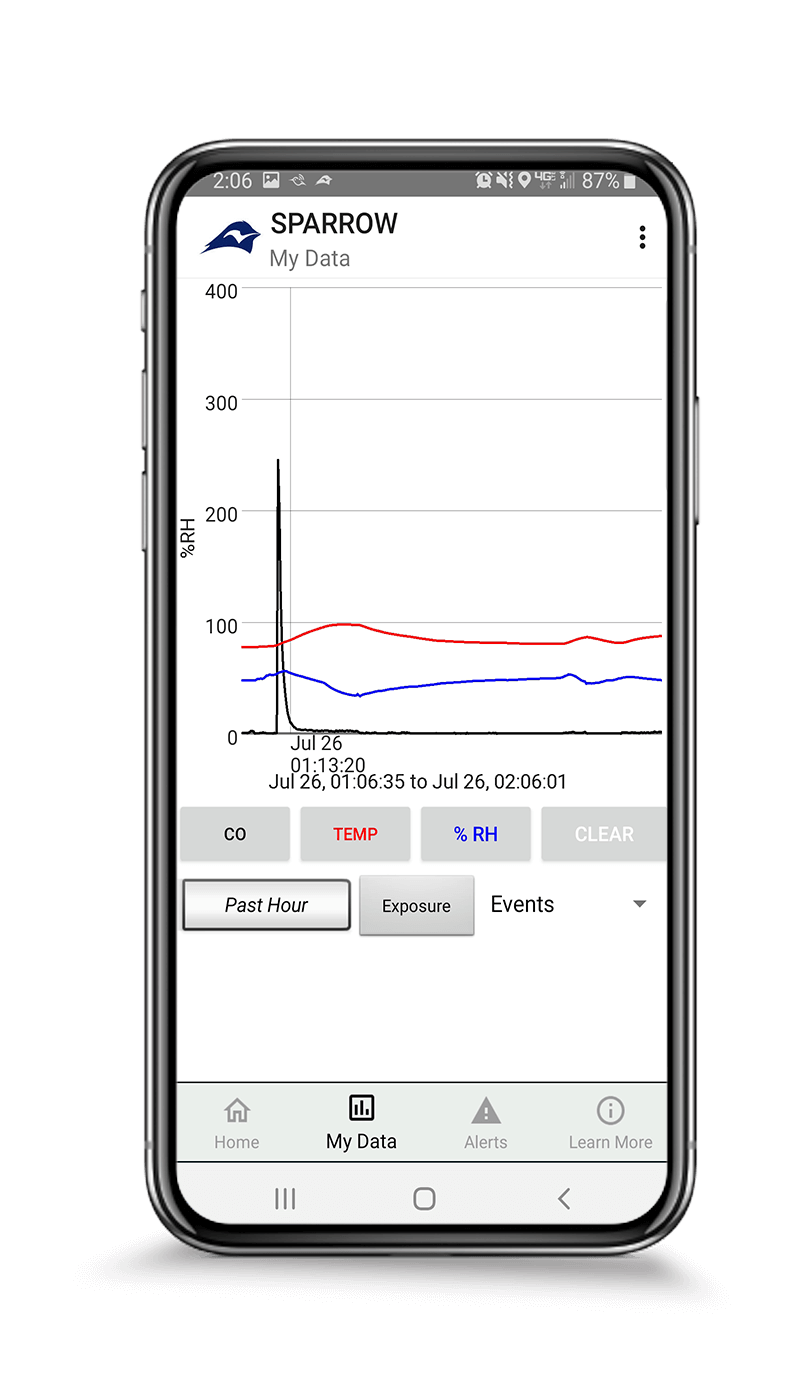
Alerts
CO exposure with time-stamp and location
What information is displayed on the Alerts page?
The Alerts page displays CO exposure data, with time, address, and GPS coordinates. You can choose to display high CO events only or to display continuous CO readings logged once every minute.
Can I use the Alerts page to track air pollution?
First, adjust the Alert Log Setting to ‘CO Pollution Logging’, this will record CO data every minute.
Second, select ‘Map View’ to view data points on the map. Use two fingers to zoom in and out to view the desired location.
Can I share this information?
Both the Alert Log and Data Log can be downloaded and shared through links on the My SPARROW page.
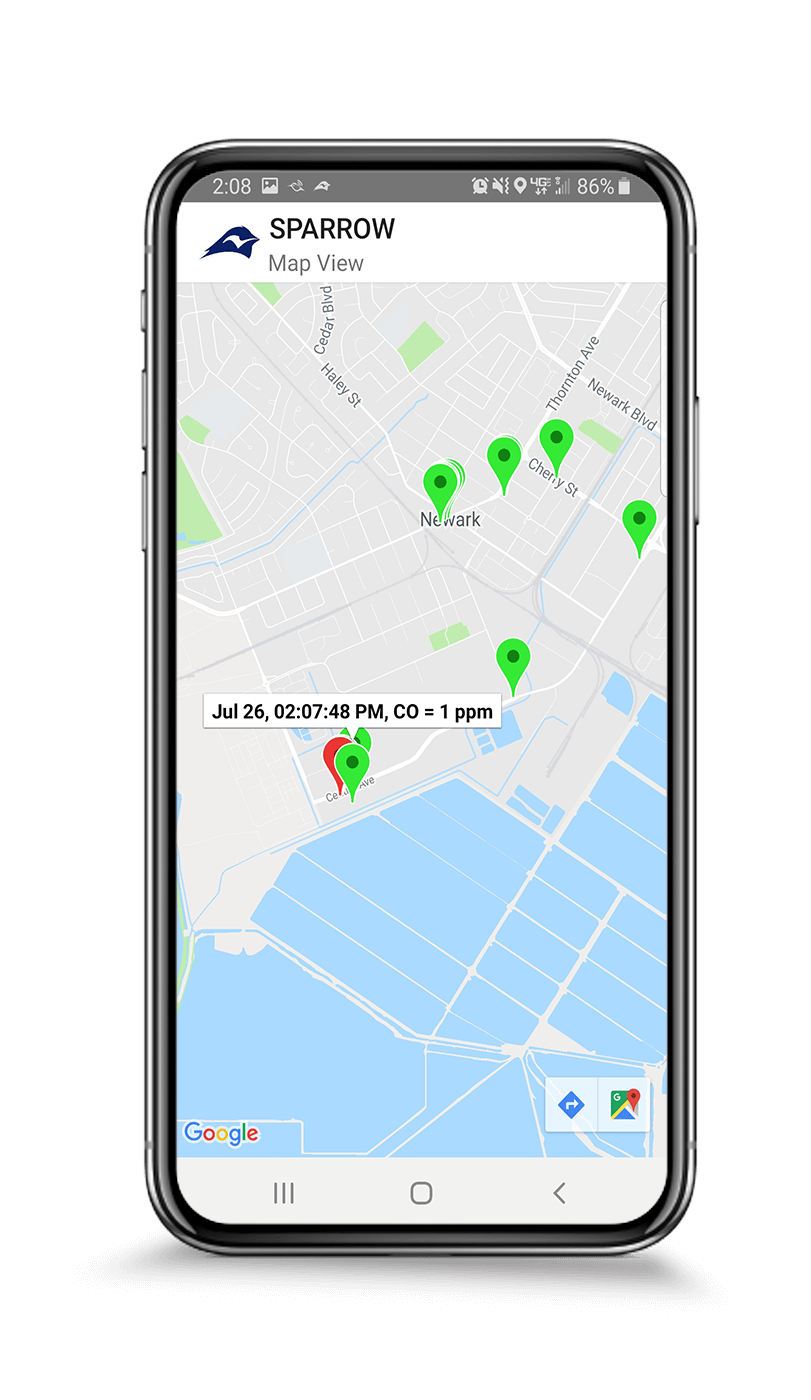
Troubleshooting Tips
Connecting SPARROW and basic operation. For more information check out the SPARROW User Manual & Visual Guide
How do I download the app?
Download the app at www.sparrowsense.com/app. The SPARROW app is available on Google Play and the App Store. Search for SPARROW CO to find the app.
When trying to connect, What if my screen is black?
After downloading the SPARROW app, press the button on the SPARROW device to connect. If you do not see your device name, or if your screen is black, swipe down on the screen to refresh.
Is SPARROW sensitive to heat?
SPARROW does not like heat! Do not place SPARROW directly near a heat source, as this will cause innacurate readings and may damage the sensor.
What if my SPARROW get’s too hot?
– If you find inaccurate readings after a major temperature spike, charge and power off your SPARROW for 24 hours. To power off your SPARROW go to Settings / Sleep Device.
Learn More About CO
What is carbon monoxide?
Carbon monoxide or CO is a toxic gas that you cannot smell, see, or taste. At high levels it is lethal, and prolonged eposure at low levels can have lasting negative health effects. CO should not be confused with CO2 or carbon dioxide the gas that people exhale and is commonly discussed in relation to climate change.
Why is carbon monoxide harmful?
When inhaled, CO binds with hemoglobin, which is the protein in red blood cel that carries oxygen (O2). Carbon monoxide competes with oxygen in the bloodstream by binding to hemoglobin and taking the place where oxygen is stored. This bound carbon monoxide is measured as a carboxyhemoglobin level. Carbon monoxide accumulates in the body and dissipates slowly in clean air; however, people who suffer prologned exposure to carbon monoxide report lasting health effects.
Am I protected from carbon monoxide?
Carbon monoxide alarms are commonly found in new homes and buildings with dual smoke and CO alarms; however, many locations are not equipped with functioning CO alarms. Carbon monoxide laws vary between states and countries and in many places CO alarms are NOT required in buildings such as homes, apartments, hotels, vacation rentals, and even restaurants and schools. Even if CO alarms are present, they do not typicaly protect against low level exposure to carbon monoxide.
Continue reading about carbon monoxide →
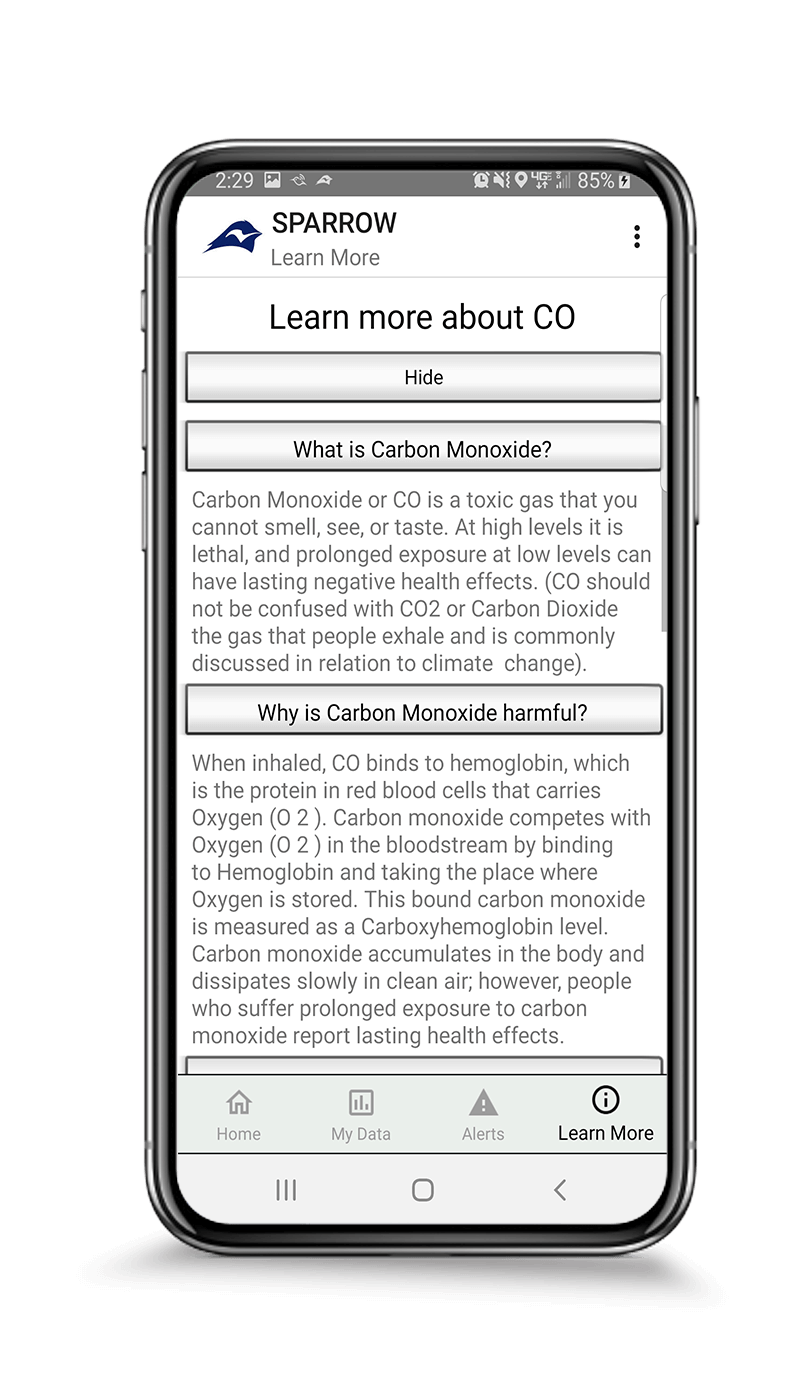
Carbon Monoxide Reference Charts
Learn More About CO
SPARROW allows you to monitor carbon monoxide in real-time.
What is carbon monoxide?
Carbon monoxide or CO is a toxic gas that you cannot smell, see, or taste. At high levels it is lethal, and prolonged eposure at low levels can have lasting negative health effects. CO should not be confused with CO2 or Carbon Dioxide the gas that people exhale and is commonly discussed in relation to climate change.
Why is carbon monoxide harmful?
When inhaled, CO binds with hemoglobin, which is the protein in red blood cells that carries oxygen (O2). Carbon monoxide competes with oxygen in the bloodstream by binding to hemoglobin and taking the place where oxygen is stored. This bound carbon monoxide is measured as a carboxyhemoglobin level. Carbon monoxide accumulates in the body and dissipates slowly in clean air; however, people who suffer prologned exposure to carbon monoxide report lasting negative health effects.
Am I protected from carbon monoxide?
Carbon monoxide alarms are commonly found in new homes and buildings with dual smoke and CO alarms; however, many locations are not equipped with functioning CO alarms. Carbon monoxide laws vary between states and countries and in many places CO alarms are NOT required in buildings such as homes, apartments, hotels, vacation rentals, and even restaurants and schools. Even if CO alarms are present, they do not typicaly protect against low level exposure to carbon monoxide.
What produces carbon monoxide?
Carbon monoxide is produced when carbon based fules do not burn completely. Any time fuel such as gas, wood, coal, charcoal, natural gas, gasoline, kerosene, propane or oil is burned, varying levels of carbon monoxide will be produced.
Carbon monoxide injuries commonly occur from:
- Exhaust from cars boats,airplanes, trucks, and recreational vehicles.
- Gas powered equipment such as generators, lawn mowers, and power washers.
- Faulty appliances such as gas heaters, gas water heaters, blocked fireplaces, stoves, and ovens. Continue reading Potential sources of CO in the home.
- Places where I may not be protected are hotels, vacation rentals, apartments, some homes, and any building not equipped with a carbon monoxide alarm.
What are potential sources of CO in the home?`
- Faulty appliances:
- Fuel burning home heating systems
- Water heaters
- Gas applianes
- Fireplaces and chimneys.
- All are designed or should exhaust CO outside. Anytime exhaust systems fail due to blockage, improper installation, and wear over time a home or building can fill with CO.
- As fuel burning systems age they may burn fuel less efficiently leading to more carbon monoxide emissions.
- Ventless fireplaces and non venting water heaters are another CO risk, as CO does not vent outside of the building.
Other sources of CO in a home or building:
- Idling cars in attached garages
- Cars left running in attached garages will fill a home or building with lethal levels of CO within hours.
- Gas powered equipment
- Gas powered generators and power washers are meant to be used outdoors and will emit lethal levels of CO in minutes.
- Improper placement of fuel burning devices
- Improper placement of fuel burning devices
- BBQ’s and Grills should only be used outdoors in well ventilated areas.
- Improper placement of fuel burning devices
What are potential sources of CO outside?
Carbon monoxide is produced from anything that burns fuel. Any time carbon monoxide is not ventilated into an open area carbon monoxide can build up.
Example of CO exposure outside the home:
- Exhaust from engines
- cars
- boats
- small aircraft
- recreational vehicles
- There is a potential for buildup of CO in exhaust anywhere, such as cars left running in enclosed spaces and boats with enclosed canopies.
- Grills, BBQ’s, and campfires
- grills and campfires should always be placed in the open and well ventilated. Be aware that CO is produced from coals and ashes after the fire has gone out!
- Travelling
- Hotels
- Vacation rentals
- Hotels and residences may not have CO detectors in every room or on every floor as laws for CO detectors vary by state and country. Faulty heating systems, water heaters, and pool heaters all pose a risk of CO exposure in hotels and vacation rentals.
Who is most at risk for CO poisoning?
While everyone is at risk for CO poisoning, sensitive individuals may be more quickly affected.
- Childrn and infants
- Their smaller size and higher rate of respiration means that CO will build up in their body more quickly.
- Pregnant women
- Carbon monoxide exposure during pregnancy can greatly affect the unborn baby leading to low birth weight and other health effects. Carbon monoxide passes through the placenta and CO decreases the level of oxygen in the mother’s blood. The fetus can suffer from hypoxia or lack of oxygen before the COL even passes to teh baby. If the mother’s CO exposure continues, the baby’s level of COHB will be 10 – 15? higher than the mothers. Read more
- Elderly
- The elderly are more quickly affected by elevated CO levels. Their bodies are less able to tolerate the lower levels of Oxygen, and other health complications make the influx of carbon monoxide felt more quickly.
- COPD, respiratory disorders, and ashtma sufferers
- Those with respiratory disorders may feel the effects of carbon monoxide more quickly as their bodies transport less oxygen and will feel the hypoxic effects more quickly. Read more
- Those who have experienced carbon monoxide poisoning and are chemically sensitive.
- People who have experienced prolonged CO poisoning report a heightened sensitivity to carbon monoxide, and report feeling the effects of dizziness and light-headness more quickly.
- Active Individuals
- Respiration increases during physical activity and more carbon monoxide, if present, will be inhaled. This is often discussed with outdoor air quality especially in urban environments. Monitoring the CO levels in outdoor air can help minimize carbon monoxide exposure.
What are the symptoms of CO poisoning?
- The early symptoms of CO poisoning are often compared to the flu, food poisoning, or allergies, and as CO levels rise more severe physical reactions occur. As every individual is different, symptoms will vary at any level of exposure.
- Headache
- Dizziness
- Weakness and clumsiness
- Hearing loss
- Blurry vision
- Changes in sense of smell and taste
- Quick irregular heartbeat and chest pain
- Disorientation
- Nausea and vomiting
- Unconsciousness and blackouts
- Convulsions and seizures
- Heart and lung failure
- Brain damage and death
Why is CO dangerous at low levels?
- Chronic low-level exposure to carbon monoxide can lead to physical health effects. It is difficult to diagnose both physically and in the environment. The CO symptoms described above often mimic other disorders or diseases, and blood tests for CO are NOT routine.
How SPARROW can help
- Your home CO alarm may not protect you from low levels of carbon monoxide. Fixed CO alarms regulated by UL do NOT alarm below 30 ppm of CO. SPARROW allows you to take action before your environment becomes toxic! SPARROW provides you with a visible display and a graphing feature through the SPARROW app that allows you to see exactly when CO levels begin to rise in your environment.
What levels of CO can I expect with my SPARROW?
- Your SPARROW is set to detect carbon monoxide levels every second. This will result in fluctuations between 0 to 3 ppm in a safe environment. If you place your SPARROW near a source of CO, you will see that it will quickly show elevated CO levels.


